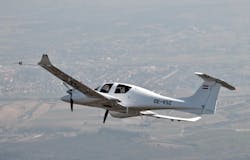Few would dispute that the days of leaded avgas are numbered. Representing less than 0.2 percent of the total refined fuel sold annually in the U.S., sales of this 'boutique' fuel have been dropping by approximately 4 percent per year for the past decade.
This is due both to a reduction in hours flown by piston aircraft, a new generation of more fuel-efficient planes, and the continued transition from large-displacement piston aircraft to turboprops and jets. Add to this its near disappearance outside North America and Europe, increasing pressure from EPA to end the last use of leaded fuel, and our dependence on the last producer of Tetra Ethyl Lead (TEL), England's Innospec.
In other words, we have all our eggs in one basket that continues to get smaller. It's only a question of which force will kill it off first — economics or environmentalists?
Alternatives In The Making
Over in Europe, where I attend the great AERO Friedrichshafen annually, the continent's largest general aviation trade show, the situation is anything but bleak. In Europe, higher prices for avgas and more severe environmental regulations forced airport and aircraft owners years ago to seek alternative fuels and develop more fuel-efficient aircraft.
Examples are the dozens of manufacturers of highly aerodynamic aircraft there, most powered by the very popular 5 gph mogas-burning four-stroke motors from Austria's Rotax, a division of Canada's BRP. Many of these aircraft are exported to the U.S. under the Light Sport Aircraft (LSA) category, the only segment of the GA industry that has experienced continued growth in the past few years.
At this year's AERO, quite a few of these European manufacturers of light aircraft displayed mockups or prototypes of larger four-seat single, light twins, and even cabin-class twins.
The engines used to power these latest aircraft constituted one of the themes of this year's show, as I described in a recent article in General Aviation News: "The engines of AERO Part II".
In summary, every piston aircraft engine on display, from a 29-hp single cylinder two-stroke motor from Italy's Poloni, to the 400-hp jet fuel-burning diesel from Austro Engines, was designed to operate on either mogas or jet fuel. These included spark-ignition mogas engines from traditional U.S. makers Continental and Lycoming, as well as a high-performance diesel engine from Continental aimed at market entry for the end of 2012.
Austria's Diamond Aircraft attracted great attention for its sleek DA-42 and new 5-7 seat DA-52 twins, both powered by the latest jet fuel diesel engines from Austro Engines, a division of Diamond.
A Multi-Fuel Environment
One gained the clear impression from attending AERO 2012 that the inevitable end to leaded avgas in Europe is a non-issue. 100LL there is only one component of a multi-fuel environment that includes leaded avgas for the dwindling fleet that requires it, mogas for the vast majority of light aircraft and next-gen engines up to about 200-hp, and jet fuel for diesels that start around 200-hp.
Todd Petersen, owner of mogas STC holder Petersen Aviation, reports brisk sales of his STCs in Europe as pilots there seek lower cost fuel and as airports end 100LL sales due to lack of demand. Mogas, which now represents about half of all the fuel burned in piston aircraft in Germany, has thankfully not been adulterated by ethanol there as is often the case at U.S. gas stations, although ethanol-free fuel is generally available at fuel terminals.
With the vast majority of legacy aircraft and most new aircraft capable of burning mogas today, the risk that a sudden end of 100LL might devastate the GA industry is unlikely. More likely is a continued decline in 100LL and increased use of mogas, and eventually jet fuel in new aviation diesel engines.
Still lacking however are avgas companies willing to supply airports with aviation-grade mogas as their counterparts in Europe have done for years. Consumers like choices, and aviation fuel should be no exception. Europeans have figured this out, and as a result today enjoy a vibrant aircraft and engine manufacturing industry that once was America's claim.
More choices in fuel lower the cost to fly and own aircraft. Lowering costs lead to more pilots, more flying, and greater revenue for airports. Tapping into the huge volume production of mogas and jet fuel compared to our boutique, lead-laden 100LL lowers the risk of losing the only fuel currently available at most airports for piston-powered aircraft. In the future, pilots may well be greeted at FBOs with the question "Mogas or Diesel?"
A Mogas Primer
Mogas (also called autogas) is lead-free, ethanol-free gasoline that meets ASTM D4814 specifications, which includes most automotive fuel. Mogas has been an FAA-approved aviation fuel since 1982, when the first mogas STCs were approved. It is capable of powering 70-80 percent of all legacy piston aircraft, most radial-engine, vintage, experimental and LSA category aircraft. Some 110 public airports currently offer mogas, as shown at www.FlyUnleaded.com.
